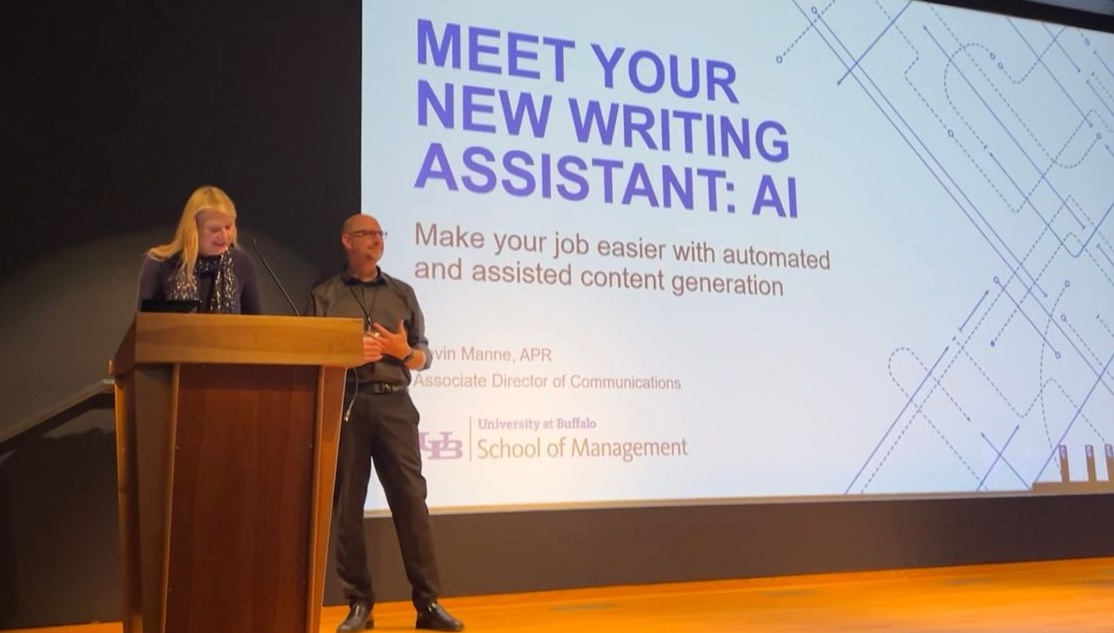Communicators partner with AI to connect research, people and purpose

Ghosen and Manne on stage at the UB Communicators Conference. Photo: Alexandra Richter
It used to take hours. Listening to the same quote five times. Typing furiously to catch every word. Pausing. Rewinding. Replaying. Transcribing interviews was the editorial equivalent of peeling potatoes — repetitive, necessary, and not exactly the stuff of storytelling magic.
But not anymore.
Today, thanks to a blend of AI tools — from ChatGPT to Zoom’s built-in transcription and Office 365 — UB School of Management communicators are bringing academic research to public understanding faster than ever. The goal? To help ideas move at the speed of relevance.
Turning dense into digestible
When a faculty member publishes a new paper on, say, risk modeling or green finance, the challenge isn’t just understanding it — it’s translating it. That’s where tools like ChatGPT come in. Instead of wrestling with paragraphs packed with jargon, the team can quickly distill key insights, test out headline ideas or reshape complicated concepts into stories that stick.
“You can ask it to summarize a 20-page research paper or pull the most quotable quote from a Zoom transcript,” says Kevin Manne, associate director of communications. “That’s time we can spend making the story stronger and more effective.”
Not just faster — more creative, too
AI isn’t only helping the School of Management’s communications team move quicker — it’s helping them think bigger. When it comes to media pitching, for example, ChatGPT can suggest lists of journalists who cover niche areas of interest, making it easier to match timely faculty research with the right newsroom. That means research on things like ESG reporting or blockchain in finance doesn’t just sit in a PDF — it gets in front of the people who can amplify it.
But the creativity goes beyond emails and press lists.
Visual storytelling matters too, especially in a media landscape driven by scrolls and swipes. For example, when a “No Parking” sign photobombed a ranking image destined for the back cover of Buffalo Business, Photoshop’s new AI “Remove” tool stepped in — seamlessly.
Other times, it’s Topaz AI Gigapixel upscaling a student’s blurry snapshot into a frame-worthy moment for social media. Every tool, every tap, contributes to a more polished final product.
The Fall 2024 cover of Buffalo Business? That was born from a prompt — a few vivid lines describing a future-forward concept, brought to life using ChatGPT’s DALL·E image generation tool. It’s not a replacement for professional photography, but it opens a new lane for visual storytelling — especially when the idea is conceptual, futuristic or hard to photograph in real life.
Even the school’s social media voice is getting a subtle AI boost. When a follower poll wrapped up last year, the team handed ChatGPT a spreadsheet of responses and got back something better than a table of numbers: a visually engaging summary that helped them share the story behind the stats. See the post here.
And when it’s time to plan something more offbeat — like a “fit check” video starring the school mascot or a centennial campaign — AI serves as a helpful creative partner, tossing out ideas, headlines and scripts that spark new directions. Not all of them stick, but that’s not the point. It’s the energy and momentum that matters.
“What’s happening with our communications tactics is more than a workflow update,” says Jacqueline Ghosen, assistant dean and director of marketing and communications. “It’s an example of how the school is living its values: using cutting-edge tools not as novelties, but as bridges.”
Because at the end of the day — or rather, at the start of a story — it still comes down to people, ideas and the spark that connects them.
This story was written by AI and edited by a member of the UB School of Management Marketing and Communications Office.